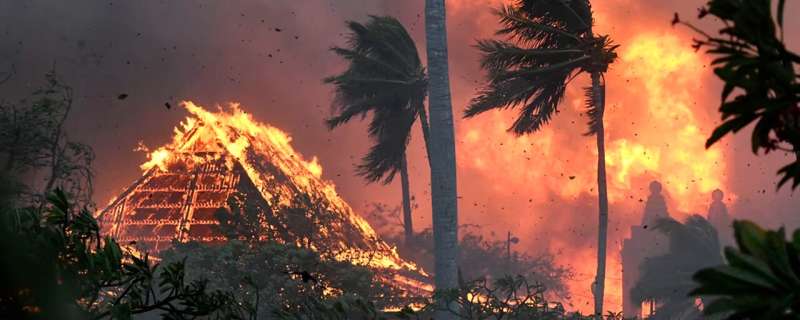This article has been reviewed according to Science X's editorial process and policies. Editors have highlighted the following attributes while ensuring the content's credibility:
fact-checked
peer-reviewed publication
trusted source
proofread
Novel framework improves resilience to extreme weather

Electricity production and distribution in the U.S. currently depends on more than 10,000 power plants, 642,000 miles of high voltage lines, 56,000 substations and 6.3 million miles of local distribution lines. Much of that infrastructure is over 30 years old.
Meanwhile, extreme weather events such as hurricanes, heat waves, wildfires and winter storms have increased in frequency and intensity.
The number of extreme weather events in the U.S. that cost $1 billion or more reached 135 between 2011 and 2020, compared with only 65 such events in the previous decade.
This combination of extreme weather and complex, aging infrastructure has resulted in significant, long-lasting blackouts from events such as the Texas winter storms in 2011 and 2021, Hurricane Maria in Puerto Rico in 2017, and the California wildfires in 2020.
To reduce the human, economic and related risks of blackouts and other types of infrastructure failures, a team associated with the Emerging Energy Markets Analysis initiative, based at Idaho National Laboratory, used a novel framework for assessing critical infrastructure's resilience—such as its ability to withstand extreme weather.
The Meta-Level Framework helps utilities, businesses and communities analyze their power infrastructure resilience and make decisions that go beyond the technology itself.
"In some ways the study of resilience is emergent," said David Shropshire, co-author of the framework and a nuclear energy economist at INL. "There's not a ready-made guide. Here's a framework—a beginning approach—that defines the key elements that we think are important to consider. It also considers resilience today versus planning for the future."
Understanding quantitative, qualitative and geospatial factors
In other words, the framework allows experts to measure resilience not only in quantitative terms such as the cost of interrupting power (measured in kilowatts) or the cost of hardening a system (measured in dollars), but also by qualitative factors such as social costs (the loss of industry or certain health effects) and ecological impacts for a region.
The framework provides a logical structure for understanding these impacts as well as knowledge gaps. It allows experts to analyze interdependencies that can cause cascading failures in infrastructure systems—for example, a power outage that cuts electricity to a water purification plant.
An article explaining the framework appears in the online journal Energies.
"We were trying to wrap our arms around what we understand about a system's resilience, quantify what we know, and qualify factors in other areas," Shropshire said. "When people think about resilience, they typically focus on the energy technology and less on other implications. That's what got us thinking about other dimensions of the problem."
Emerging energy markets analysis
The framework was developed under the INL-led Emerging Energy Markets Analysis (EMA) initiative. The initiative is a collaboration among INL, the University of Alaska, Boise State University, Massachusetts Institute of Technology, the University of Michigan, the University of Wyoming and the University of Utah. It helps states and regions transition to clean energy technologies, including nuclear energy.
The framework comes as the U.S. grappled with a host of extreme weather events during the summer of 2023—devastating wildfires on Maui, flooding in New England, and extreme heat across the southern and central parts of the country, to name a few.
The methodology also coincides with the passage of federal laws, including the Inflation Reduction Act of 2022, which make funding available to help communities increase the resilience of their critical infrastructure and transition to zero-carbon technologies.
EMA connects those communities with academic researchers who can help them apply the framework to solve resilience challenges.
"Partnering with groups like EMA is an opportunity to have a trusted broker provide analysis that is locally relevant," said framework co-author Kathleen Araújo, who is the director of the Energy Policy Institute, the policy arm of the Center for Advanced Energy Studies, and professor of Sustainable Energy Systems, Innovation and Policy at Boise State University.
Resilience is always close at hand
"EMA has worked with the states of Wyoming and Alaska to understand the economic, industrial, community and environmental influences that shape choices which communities in these two states will be making," Araújo said. "Resilience is always closely aligned with these decisions."
The framework provides a way for communities to navigate a range of options. "Communities and members of industry are recognizing that they need to make some hard choices with resilience and energy security ranking high among priorities," Araújo said. "Thoughtful decision-makers know that you can't just look at economics. There's so much more involved in these choices."
The Meta-Level Framework is one of several efforts at INL to advance systems resilience and risk management. Visit inl.gov and resilience.inl.gov for more information.
More information: Kathleen Araújo et al, A Meta-Level Framework for Evaluating Resilience in Net-Zero Carbon Power Systems with Extreme Weather Events in the United States, Energies (2021). DOI: 10.3390/en14144243


















